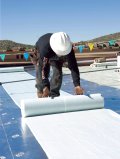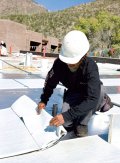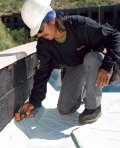
Modified bitumen membranes were originally designed for roofing applications, but they have become more prominent as waterproofing materials over the last decade. The product pictured is JMCleanBond, a self-adhered system. (Photos courtesy of Johns Manville.)

Modified bitumen sheets can be used on horizontal and vertical surfaces. Here, self-adhered JMCleanBond is installed at a parapet wall.
1. Atactic Polypropylene (APP)
2. Styrene-Butadiene-Styrene (SBS)
3. Styrene Ethylene Butadiene Styrene (SEBS)
Atactic Polypropylene
APP is manufactured by adding a waste byproduct of polypropylene called amorphous polypropylene to asphalt (30 percent to 50 percent) over a reinforcement sheet. The reinforcement is a heavy spun bonded polyester mat. The polyester mat provides the proper durability and elongation stability necessary for the APP modified asphalt.
APP sheets are applied to the substrate by torch application. The APP membrane sheets can be torch applied because the APP modifiers extend the asphalt without changing its basic characteristics. This allows for a thicker asphalt content to be applied to the base of the membrane sheet. The additional asphalt content of the sheet - when torched - provides the adhesive capacity of the membrane to the substrate. The polymer chemistry of APP modified asphalt consists of 25 percent to 30 percent of polypropylene added to asphalt mixed and blended for 4 to 6 hours.
Styrene-Butadiene-Styrene
SBS asphalt uses 10 percent to 15 percent of a rubber polymer called styrene-butadiene-styrene as an additive to the asphalt modifier. When the rubber polymer is added to the asphalt, it goes through an inversion phase from a compound into an isometric form. This form of modified asphalt has many of the characteristics of rubber, including its excellent elongation capacities.
When applied over fiberglass reinforcement, SBS membrane sheets have the inert capacity to stretch and recover to their original shape. Tests conducted have indicated that SBS modified asphalt with 10 percent rubber content can be stretched to six times its original length without breaking and have the capacity to fully recover to their original shape. SBS membrane sheets can be applied with hot asphalt or solvent-based and waterborne liquid adhesives.
The blending technology of SBS modified bitumen is critical to the success of the sheet. When the bitumen and synthetic rubber polymer are blended, there is a tendency for high polymer liquids not to mix with each other. This causes a phase separation, which can be clearly observed under a microscope. The SBS blend typically consists of the SBS polymer, asphalt and other low-level fillers, such as limestone (15 percent content). Some manufacturers add substances that inhibit the oxidation of the asphalt. The components are blended together with the reinforcement at 350 to 390 degrees Fahrenheit for 3 to 5 hours.
Styrene Ethylene Butadiene Styrene
The manufacturing process of modified bitumen adhesive (SEBS) is similar to the emulsion process except polymers, such as rubber, are added to the asphalt. The modified asphalt blend is mixed with the water and clay stabilizers. Waterborne products cure with heat; the greater the heat, the quicker the cure time. In contrast to solvent-based products, humidity slows down the curing process.

JMCleanBond is installed over a 1-inch ENRGY 3 Foil Face insulation.
There are two types of reinforcements that are primarily used with modified bitumen systems, polyester and fiberglass.
Polyester
The use of polyester reinforcements is widespread in SBS modified bitumen systems. The primary benefit of using polyester in SBS systems is for its high elongation capabilities. This is well suited to the performance of the SBS modified bitumen coating. Polyester also exhibits high puncture resistance, tear strength and the durability to withstand high traffic. Polyester’s ability to withstand high temperatures accounts for its predominant use with APP modified bitumen. Polyester can remain dimensionally stable during the torching application or when applied in hot asphalt.
Fiberglass
Fiberglass exhibits superior dimensional stability and tensile strength to polyester. Fiberglass is not affected by heat or tension. When a fire retardant formulation is applied, fiberglass can provide excellent fire resistance on SBS systems. Fiberglass has excellent tensile strength, and when used in SBS sheets they will resist roof movement until the stress building up in the mat forces it to break. Modified bitumen sheets are manufactured to widths of 36 to 39 inches. The thickness of the modified sheets range from 120 to 170 mils. The typical sheet manufacture process is comprised of:
• Mixing and holding of the modified bitumen membrane.
• A saturation tank for dipping the reinforcement material through the hot modified bitumen mix.
• A rolling cylinder sheet with contact cooling.
• A spray bar for applying powder to prevent cohesion between the wound sheets.
• A winding machine to allow continuous production without stopping the line.
• A packing machine.

Waterproofing is a crucial element of plaza and deck design.
Modified bitumen waterproofing membranes are suitable for all three waterproofing components: structural slabs, slabs on grade and foundation walls. They have gained prominence as a waterproofing material primarily by evolving into advanced builtup systems. In addition to providing the advantages of requiring less labor and offering more application options (set in hot asphalt, set in cold adhesive, selfadhered), modified bitumens have superior properties to built-up systems. The breaking strain of modified bitumen is 150 percent, compared to 2 percent for built-up systems. They have much higher coldtemperature flexibility and resist tensile and flexural stresses that would rupture a built-up membrane. Another advantage of modified bitumen products is that because they are factory manufactured, the thicknesses of the sheets are controlled and consistent. Multiple plies of built-up or multiple layers of LAMs would be required to achieve the same thickness. This is a primary advantage of on vertical surfaces.
Due to the presence of continual water over the membrane, modified sheets used in waterproofing systems require a protective film. The most predominant modified membrane consists of a 56-mil SBS sheet laminated to a 4-mil highdensity polyethylene (HDPE) film. The HPDE film over the modified sheet provides the following advantages:
• Increased tensile strength and breaking strain.
• Resistance to acid soils and organic growth.
• Improved resilience, self-healing property, and bondability.
• Easier joint seaming.
• Improved resistance to vapor flow.
• Enhanced crack bridging.
• Improved bonding adhesion.

The bond formed with JMClean- Bond strengthens over time.
The disadvantages of modified sheets are:
• Unsuitable for blind side application.
• They do not adhere to slabs-on-ground when they are applied to the mud mat.
• Poor ultraviolet radiation resistance; they should not be exposed.
• Application temperatures can be limited to 40 degrees F and higher.
Waterproofing Application Methods
Modified sheets can be set in cold adhesive, set in a hot mopping or self-adhered. In cold-adhesive applications, the membrane is applied shingle fashion to the adhesive over the substrate. The sheet is rolled in on horizontal planes and hung on vertical surfaces. The number of plies depends on the existence of hydrostatic pressure and can range from one to three plies. The adhesive reacts with the polymer and the modified sheet and fuses them together. After curing, the modified sheets form a monolithic surface and the membrane becomes an integral reinforced sheet rather than a multi-ply laminate.
Self-adhered sheets can be applied to vertical and horizontal surfaces. The substrate must be properly prepared, smooth and free of all irregularities and depressions. The substrate is then primed with the manufacturers approved primer. The primer should be applied in an even application at the rate required by the manufacturer. The sheets release film is removed as the membrane is placed in position and applied over the substrate. The sheet is rolled and pressed into the primer during the application process. Typically, a minimum 6-inch wide strip is applied over butt joints in a primer and rolled over for proper adhesion. According to some manufacturers, the tape-membrane splice tests at a higher parallel shear strength (33 psi) than the membrane-concrete adhesion.